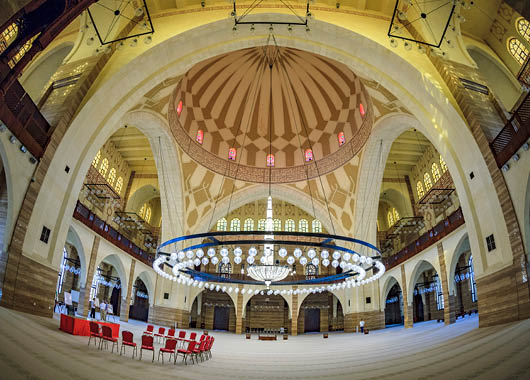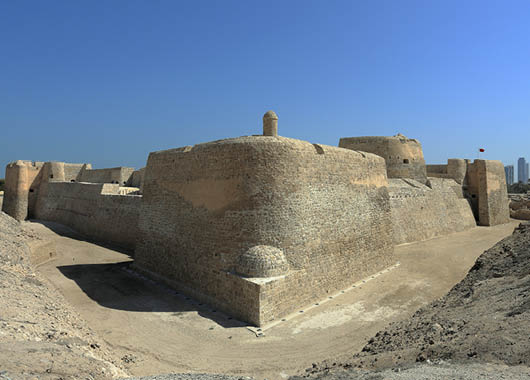
Al Fateh Mosque
The Al-Fateh Mosque (also known as Al-Fateh Islamic Center & Al Fateh Grand Mosque) (Arabic: مسجد الفاتح; transliterated: Masjid al-Fatih) is one of the largest mosques in the world, encompassing 6,500 square meters and having the capacity to accommodate over 7,000 worshippers at a time. The mosque was built by the late Sheikh Isa bin Salman Al Khalifa in 1987 and was named after Ahmed Al Fateh. In 2006, Al-Fateh became the site of the National Library of Bahrain. The mosque is the largest place of worship in Bahrain. It is located next to the Al Fateh Highway in Juffair, which is a suburban neighborhood of Manama.

The huge dome built on top of the Al-Fateh Mosque is constructed entirely of fiberglass. Weighing over 60 Tons, the dome is currently the world's largest fiberglass dome. The marble used in the floors is Italian and the chandelier is from Austria. The doors are made of teak wood from India. Throughout the mosque is Kufic calligraphy. The library of Ahmed Al-Fateh Islamic Center has around 7,000 books, some as old as 100 years or more.
These include copies of the books of the teachings of Prophet Muhammad or what is referred to as the books of Hadith, the Global Arabic Encyclopedia and the Encyclopedia of Islamic Jurisprudence, Al-Azhar journals which have been printed more than a hundred years ago, as well as numerous periodicals and magazines. Besides being a place of worship, the mosque is one of the premier tourist attractions in Bahrain.
It is open from 9am to 4pm and tours are conducted in a variety of languages including English, French, Filipino, Russian and many other languages, special arrangements are encouraged for smooth sailing. The mosque is open to visitors and tourists on all Fridays.

The Qal'at al-Bahrain (Arabic: قلعة البحرين; Portuguese: Forte de Barém), also known as the Bahrain Fort or Portuguese Fort, is an archaeological site located in Bahrain. Archaeological excavations carried out since 1954 have unearthed antiquities from an artificial mound of 12 m (39 ft) height containing seven stratified layers, created by various occupants from 2300 BC up to the 18th century, including Kassites, Greeks, Portuguese and Persians. It was once the capital of the Dilmun civilization and was inscribed as a UNESCO World Heritage Site in 2005. The fort and the tell Qal'at al-Bahrain is built on, are located on the Bahrain island, on the northern seashore. On a clear day it is also seen from Saar. It stands like a "sentinel" near Manama, the capital of Bahrain; it is 6 km (4 mi) away from Manama on the fertile north coast. The tell is the largest in the Persian Gulf region and was built close to the port and by reclamation of seashore land. The archaeological findings, which are unearthed in the fort,reveal much about the history of the country. The area is thought to have been occupied for about 5000 years and contains a valuable insight into the Copper and Bronze Ages of Bahrain.




